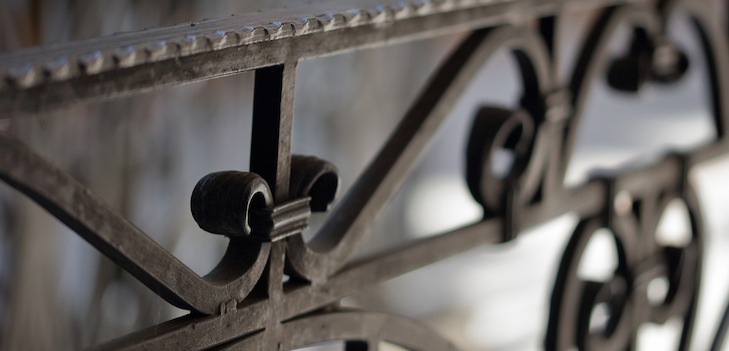Ornamental and wrought iron are beautiful and add a dramatic flair. It showcases staircases, gates, fences, railings, decking, etc. Custom quality ironwork and welding with ornamental iron can take your home or commercial space to the next level.
You’ll want to protect it from the elements and from rust.
What is Rust?
Rust is a form of iron oxide. It occurs when iron combines with the oxygen in the air causing it to corrode. Rust is the orange-brown discoloration that builds up on metal.
Does wrought iron rust?
Yes. Rust can affect iron and its alloys, including steel. Whenever you have iron, water, and oxygen together, you get rust. The main catalyst for rust to occur is water. Although iron and steel structures seem solid to the eye, water molecules are able to penetrate microscopic gaps in the metal. This starts the process of corrosion. If salt is present, for example in seawater, the corrosion will be more rapid. Exposure to sulfur dioxide and carbon dioxide will also hasten the corrosive process.
Rust causes the metal to expand, which can place great stress on the structure as a whole. At the same time, the metal will be weakened and become brittle and flaky. Rust is permeable to air and water, so the metal beneath the rust layer will continue to corrode.
7 Ways to Prevent Wrought Iron From Rusting
Ferrous metals like iron and steel can oxidize to form rust. This weakens the metal and can cause the part to fail. To avoid rust and corrosion, a variety of different coatings can be applied to the metal. Coatings are designed to prevent oxidation by keeping the part from exposure to oxygen and water. Zinc coatings protect ferrous metals from rusting by a different means — zinc is oxidized before zinc-coated metal parts start to rust. The zinc coating will corrode instead of the protected ferrous metal part. Anodizing is a process for non-ferrous metals that reduces or eliminates corrosion.
Rust can compromise your metals’ strength, making them fragile and shortening their lifespan. When it comes to keeping your metals looking their best while also maintaining durability, preventing rust in the first place is key. Exposure to outdoor conditions will increase the risk of rust, especially if the climate is rainy or humid.
To protect your wrought iron from Florida weather and humidity, there are types of protective coating you can use. Here are a few examples:
1. FOZZ
FOZZ is a balanced blend of Phosphoric Acid and other chemicals, wetting agents, and extenders that dissolve rust and prevent further rusting. Properly treated surfaces are ready to paint when dry. FOZZ is not a paint, but a primer that conditions metal so that paint will adhere.
2. Powder Coating
Powder coating is when a dry powder is evenly applied to a clean surface. Then, the object is heated, turning the powder into a thin film. Acrylic, polyester, nylon, vinyl, epoxy, and urethane powders are available. Powders are applied using an electrostatic spray process. The electrically conductive object is sprayed with a charged, non-conducting powder.
3. Organic Coating
A cost effective way to protect against rust is using an organic coating that forms a barrier against corrosive elements. Oil based coatings are ideal for preventing the penetration of water and oxygen.
4. Galvanizing
Galvanizing is a method of rust prevention. This is accomplished through hot-dip galvanizing or electroplating. The iron or steel object is coated in a thin layer of zinc. This stops oxygen and water from reaching the metal underneath but the zinc also acts as a sacrificial metal. Zinc is more reactive than iron, so it oxidizes in preference to the iron object.
5. Proper Pre-Design
The design should allow air to freely circulate around the metal. Proper planning during the design stage can minimize water penetration and reduce the risk of rust. Crevices and cavities should be avoided. Metal joints should be welded not bolted. If appropriate, drainage holes for water should be considered. For large structures, adequate access should be enabled to allow for regular maintenance.
6. Bluing
Bluing is immersing the steel parts into a solution of potassium nitrate, water, and sodium hydroxide and is a useful technique that offers limited protection for small steel items against rust. The reason it is called “bluing” is because of the blue-black appearance of the finish when using this technique. It is often used in manufacturing firearms to provide a degree of corrosion resistance. It’s also used in fine clocks and other metalwork.
7. Regular Maintenance
If you build in regular maintenance it will help to stop rust from forming and halt the progress of any rust that occurred. It’s crucial to remove any rust that has formed. A razor blade can be used for small areas. Using warm water and soap, surface grime should be removed. Then, a rust resistant coating should be applied to the surface.
Visit Tampa Steel & Supply for Wrought Iron Fencing
Are you in need of steel supplies? Look no further than the professionals at Tampa Steel & Supply. We stock an extensive list of steel products for whatever project you need to tackle. We’re proud to have served our customers for nearly four decades and are ready to assist you with your steel needs. Have questions? Give us a call today to learn more, or stop by our beautiful Tampa showroom.
Request a Quote Online
Or Call Tampa Steel & Supply at (813) 241-2801

